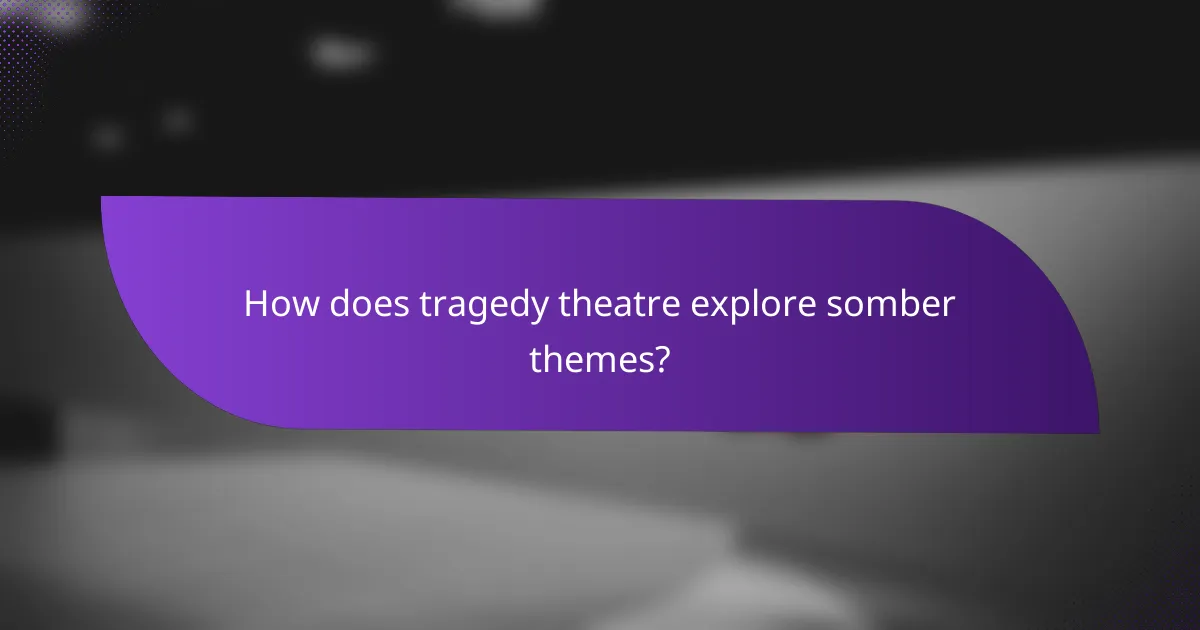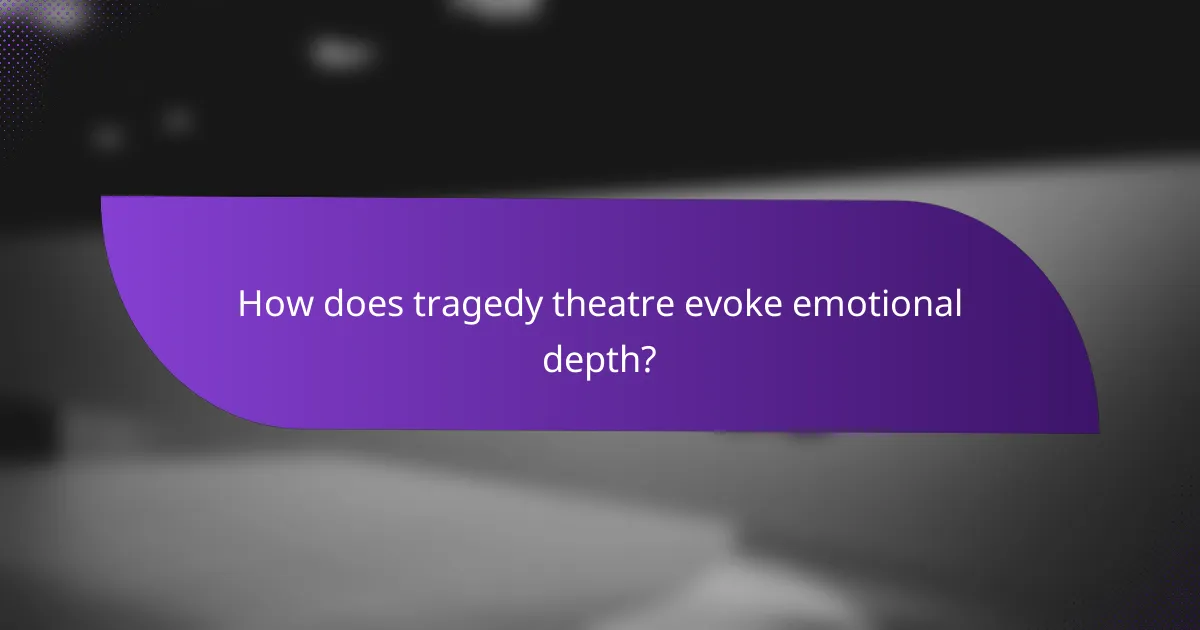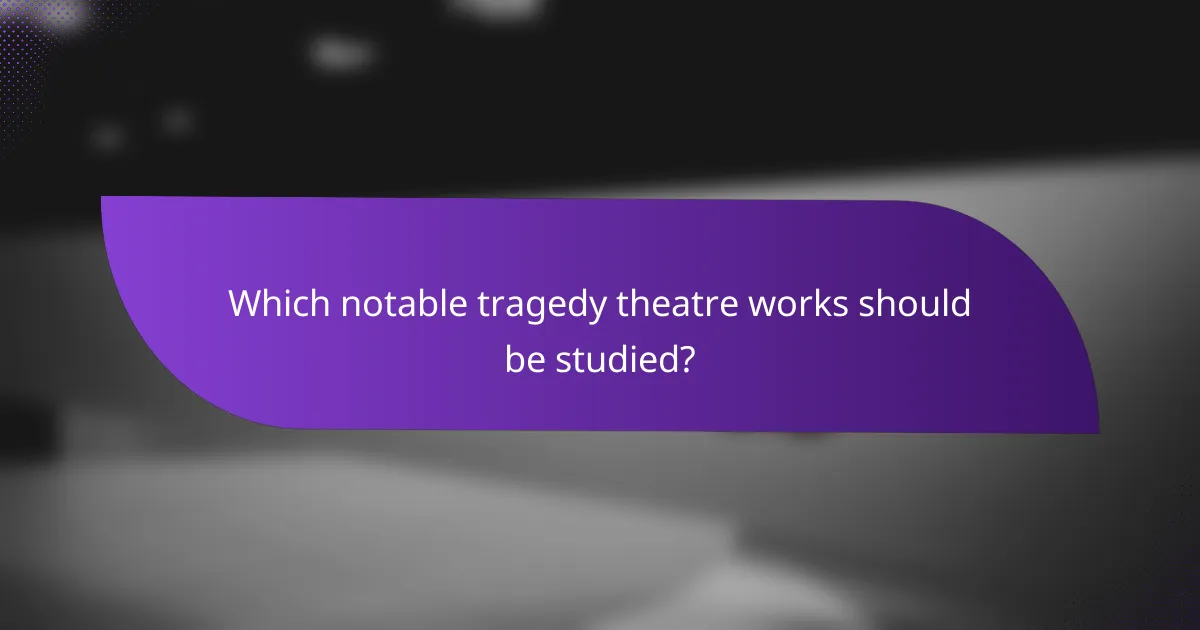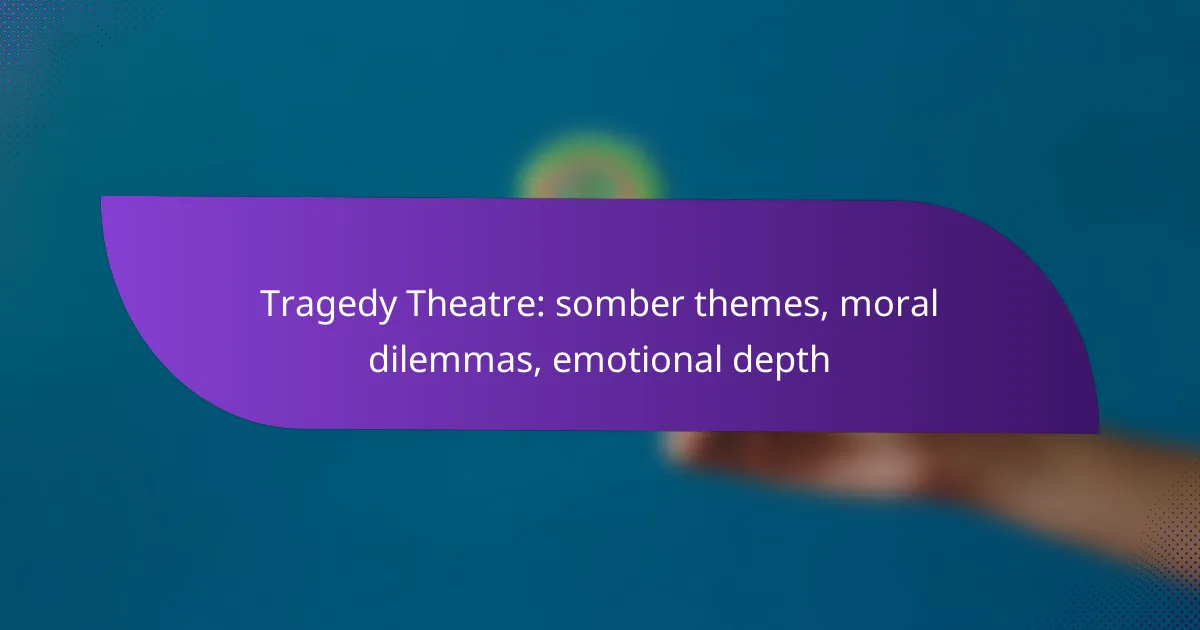Tragedy theatre immerses audiences in somber themes that reflect the darker facets of human existence, often centering on moral dilemmas and emotional depth. By presenting complex characters grappling with profound ethical questions, it invites viewers to confront uncomfortable truths about life, suffering, and the human condition.

How does tragedy theatre explore somber themes?
Tragedy theatre delves into somber themes by portraying the darker aspects of human existence, often highlighting moral dilemmas and emotional depth. Through its narratives, it invites audiences to confront uncomfortable truths about life, suffering, and the human condition.
Depiction of human suffering
Tragedy theatre vividly illustrates human suffering by showcasing characters who endure profound pain and loss. This portrayal often serves to evoke empathy from the audience, allowing them to connect with the characters’ struggles on a personal level.
Examples include classic works like Shakespeare’s “Hamlet,” where the protagonist grapples with grief and betrayal, or Euripides’ “Medea,” which explores the depths of anguish and revenge. Such narratives highlight the universal nature of suffering, making it relatable across cultures and eras.
Confrontation with mortality
Tragedy theatre forces audiences to confront mortality by presenting characters facing death or existential crises. This theme often raises questions about the meaning of life and the inevitability of death, prompting reflection on one’s own mortality.
For instance, in “Death of a Salesman” by Arthur Miller, Willy Loman’s struggle with his own insignificance and the pursuit of the American Dream culminates in a tragic end. Such confrontations with mortality can lead to a deeper appreciation of life and the choices one makes.
Exploration of fate and free will
Tragedy theatre examines the tension between fate and free will, often portraying characters caught in circumstances beyond their control. This exploration raises questions about the extent to which individuals can shape their destinies versus being subject to predetermined outcomes.
A notable example is Sophocles’ “Oedipus Rex,” where Oedipus’s attempts to escape his fate ultimately lead him to fulfill it. This interplay between fate and choice encourages audiences to reflect on their own lives and the forces that influence their decisions.

What moral dilemmas are presented in tragedy theatre?
Tragedy theatre often explores complex moral dilemmas that challenge characters’ values and decisions. These dilemmas reveal the emotional depth of human experience, highlighting the conflicts between personal desires and societal expectations.
Conflict between duty and desire
The conflict between duty and desire is a central theme in many tragic narratives. Characters frequently face situations where their obligations to family, society, or themselves clash with their personal aspirations or passions. For instance, a soldier may struggle with the desire to protect his loved ones while feeling compelled to serve his country.
This tension can lead to profound emotional turmoil, as characters must weigh the consequences of their choices. The resolution of such conflicts often results in significant personal sacrifice or tragedy, emphasizing the weight of their decisions.
Ethical choices leading to downfall
Tragedy theatre often portrays ethical choices that lead to a character’s downfall. These choices may stem from ambition, jealousy, or a misguided sense of justice. For example, a ruler might choose to betray a trusted advisor in pursuit of power, ultimately resulting in their own ruin.
Such narratives serve as cautionary tales, illustrating how flawed decisions can spiral into catastrophic outcomes. The moral implications of these choices resonate with audiences, prompting reflection on their own ethical boundaries.
Consequences of revenge
The theme of revenge is prevalent in tragedy theatre, often showcasing its destructive consequences. Characters driven by vengeance may initially feel justified, but their actions frequently lead to unintended suffering and loss. A classic example is the tale of Hamlet, where the quest for revenge ultimately results in multiple tragedies.
This theme underscores the futility of revenge and its ability to perpetuate cycles of violence. Audiences are left to ponder the moral implications of seeking retribution, often questioning whether justice can truly be achieved through such means.

How does tragedy theatre evoke emotional depth?
Tragedy theatre evokes emotional depth by exploring profound themes and moral dilemmas that resonate with the human experience. Through intense character arcs and poignant narratives, audiences are invited to confront their own emotions and ethical questions.
Character-driven narratives
Character-driven narratives are central to tragedy theatre, as they focus on complex individuals facing significant challenges. These characters often undergo profound transformations, revealing their vulnerabilities and strengths. For example, a tragic hero may grapple with personal loss or moral failure, allowing the audience to connect deeply with their plight.
In many cases, the audience witnesses the characters’ internal struggles, which heightens emotional engagement. This connection fosters empathy, as viewers reflect on their own lives and the choices they face.
Use of catharsis
Catharsis is a key element in tragedy theatre, providing a means for audiences to experience and release pent-up emotions. By witnessing the suffering and eventual downfall of characters, viewers can confront their own fears and anxieties in a safe environment. This emotional release can lead to a sense of relief and clarity.
The process of catharsis often involves a mix of pity and fear, allowing audiences to reflect on the consequences of human actions. This reflection can lead to personal insights and a deeper understanding of moral complexities.
Impact of tragic flaws
Tragic flaws, or hamartia, significantly impact the emotional depth of tragedy theatre. These flaws are inherent weaknesses in a character that ultimately lead to their downfall, making them relatable and human. For instance, a character’s excessive pride or inability to adapt can resonate with audiences, prompting them to consider their own shortcomings.
The exploration of tragic flaws encourages viewers to engage with the narrative on a deeper level, as they recognize the universal nature of these imperfections. This recognition can evoke feelings of compassion and introspection, enhancing the overall emotional experience of the performance.

What are the key characteristics of tragedy theatre?
Tragedy theatre is defined by its serious tone, exploration of moral dilemmas, and profound emotional depth. These characteristics combine to create a narrative that often leads to the protagonist’s downfall, reflecting universal truths about the human condition.
Serious tone and themes
The serious tone in tragedy theatre sets the stage for exploring weighty themes such as fate, justice, and the human struggle. These themes often evoke deep emotional responses from the audience, prompting reflection on moral complexities and societal issues.
Common themes include the conflict between individual desires and societal expectations, the consequences of hubris, and the inevitability of death. Such themes resonate across cultures and time periods, making tragedy a timeless form of storytelling.
Protagonist’s downfall
A central element of tragedy is the protagonist’s downfall, which typically arises from a tragic flaw or error in judgment known as hamartia. This downfall is not merely a personal failure but often reflects broader societal or existential dilemmas.
For example, in Shakespeare’s “Macbeth,” the protagonist’s ambition leads to his ruin, illustrating how personal desires can conflict with moral integrity. This downfall serves to highlight the fragility of human existence and the consequences of one’s choices.
Universal truths
Tragedy theatre often reveals universal truths about life, such as the inevitability of suffering and the complexity of human emotions. These truths resonate with audiences, fostering a sense of empathy and understanding for the characters’ struggles.
By confronting difficult realities, tragedy encourages viewers to reflect on their own lives and the moral choices they face. This connection to universal experiences makes tragedy a powerful medium for exploring the depths of human nature and societal values.

Which notable tragedy theatre works should be studied?
Studying notable tragedy theatre works provides insight into complex human emotions and moral dilemmas. Key examples include Shakespeare’s “Hamlet” and Euripides’ “Medea,” both of which explore themes of revenge, betrayal, and the consequences of personal choices.
Shakespeare’s “Hamlet”
Shakespeare’s “Hamlet” is a quintessential tragedy that delves into themes of madness, revenge, and moral ambiguity. The protagonist, Prince Hamlet, grapples with avenging his father’s murder while questioning the morality of his actions and the nature of existence.
Key elements to consider include Hamlet’s internal conflict and the play’s exploration of existential questions. The famous soliloquy “To be, or not to be” encapsulates the emotional depth and philosophical inquiries that define the work.
Euripides’ “Medea”
Euripides’ “Medea” presents a powerful narrative centered on betrayal and vengeance. The protagonist, Medea, faces profound moral dilemmas after her husband, Jason, abandons her for another woman, sparking her quest for revenge.
This tragedy highlights the extremes of human emotion and the consequences of betrayal. Medea’s actions, driven by passion and despair, prompt audiences to reflect on the nature of justice and the limits of empathy.
